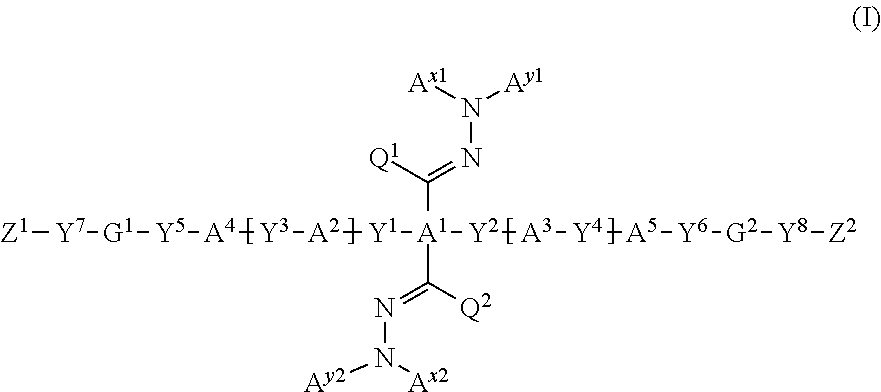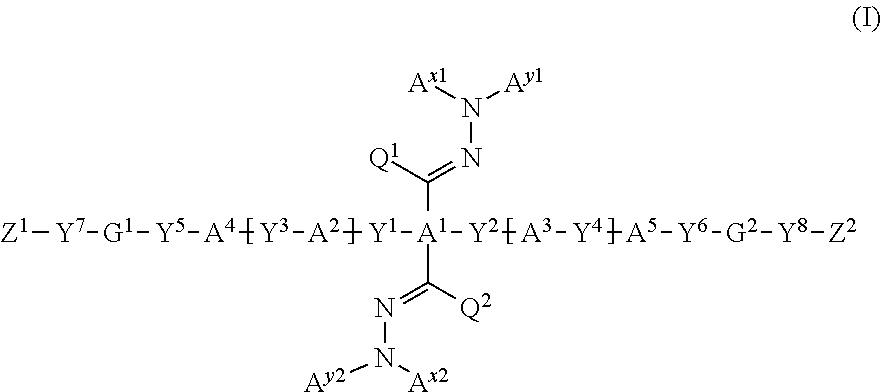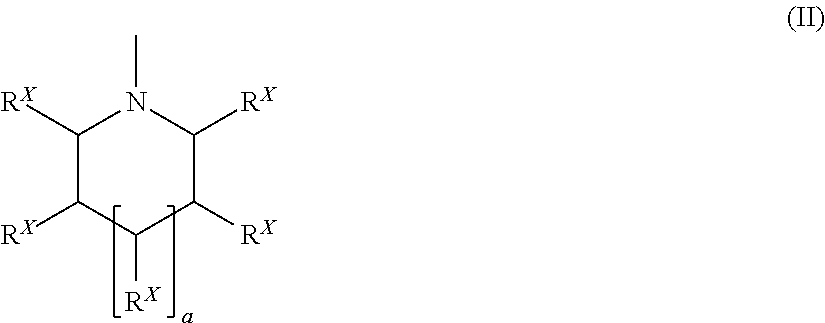Polymerizable compound, polymerizable composition, polymer, and optically anisotropic substance
- Summary
- Abstract
- Description
- Claims
- Application Information
AI Technical Summary
Benefits of technology
Problems solved by technology
Method used
Image
Examples
example 1
Synthesis of Compound 1
[0222]
Step 1: Synthesis of Intermediate A
[0223]
[0224]A three-necked reactor equipped with a thermometer was charged with 7.0 g (50.67 mmol) of 1,4-dimethoxybenzene, 29.44 g (253.33 mmol) of N,N,N′,N′-tetramethylethylenediamine, and 280 ml of diethyl ether under a nitrogen stream to prepare a homogeneous solution. After cooling the solution to 0° C., 97.4 ml (253.33 mmol) of 2.6 M n-butyllithium (n-hexane solution) was added dropwise to the solution over 30 minutes. After the dropwise addition, the reaction mixture was reacted for 5 hours under reflux, and then cooled to −78° C. After the addition of 18.52 g (253.33 mmol) of N,N-dimethylformamide, the mixture was stirred at −78° C. for 1 hour. After the addition of 350 ml of a 3 N hydrochloric acid aqueous solution to the reaction mixture at −78° C., the mixture was heated to 25° C., and 300 ml of distilled water and 200 ml of a saturated sodium chloride solution were added to the mixture, followed by extractio...
example 2
Synthesis of Compound 2
[0238]
[0239]A three-necked reactor equipped with a thermometer was charged with 5.0 g (7.0 mmol) of the intermediate C synthesized in the step 3 of Example 1 and 50 ml of THF under a nitrogen stream to prepare a homogeneous solution. After the addition of 1.4 ml (1.4 mmol) of 1 N hydrochloric acid to the solution, 2.4 g (21.0 mmol) of 1-amino-4-methylpiperazine was added dropwise to the mixture at 25° C. over 15 minutes. After the dropwise addition, the mixture was stirred at 25° C. for 5 hours. After completion of the reaction, 300 ml of distilled water and 150 ml of a saturated sodium chloride solution were added to the reaction mixture, followed by extraction twice with 200 ml of ethyl acetate. The organic layer was collected, and dried over anhydrous sodium sulfate, and sodium sulfate was filtered off. The solvent was evaporated from the filtrate under reduced pressure using a rotary evaporator. The residue was purified by silica gel column chromatography ...
example 3
Synthesis of Compound 3
[0242]
[0243]A three-necked reactor equipped with a thermometer was charged with 1.0 g (1.4 mmol) of the intermediate C synthesized in the step 3 of Example 1, 30 ml of THF, and 3 ml of methanol under a nitrogen stream to prepare a homogeneous solution. After the addition of 0.92 g (4.2 mmol) of 1,1-diphenylhydrazine hydrochloride to the solution over 10 minutes, the mixture was stirred at 25° C. for 1 hour, and then stirred at 40° C. for 2 hours. After completion of the reaction, 150 ml of distilled water and 150 ml of saturated sodium bicarbonate water were added to the reaction mixture, followed by extraction twice with 200 ml of ethyl acetate. The organic layer was collected, and dried over anhydrous sodium sulfate, and sodium sulfate was filtered off. The reaction mixture was concentrated using a rotary evaporator, and the concentrate was purified by silica gel column chromatography (chloroform:THF=98:2) to obtain 1.34 g of a compound 3 as a yellow solid (...
PUM
| Property | Measurement | Unit |
|---|---|---|
| Solubility (mass) | aaaaa | aaaaa |
| Melting point | aaaaa | aaaaa |
| Anisotropy | aaaaa | aaaaa |
Abstract
Description
Claims
Application Information
 Login to View More
Login to View More - R&D
- Intellectual Property
- Life Sciences
- Materials
- Tech Scout
- Unparalleled Data Quality
- Higher Quality Content
- 60% Fewer Hallucinations
Browse by: Latest US Patents, China's latest patents, Technical Efficacy Thesaurus, Application Domain, Technology Topic, Popular Technical Reports.
© 2025 PatSnap. All rights reserved.Legal|Privacy policy|Modern Slavery Act Transparency Statement|Sitemap|About US| Contact US: help@patsnap.com



